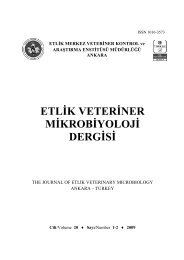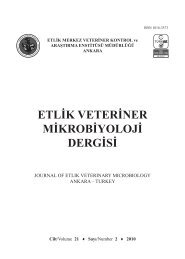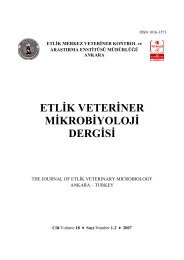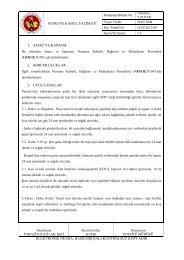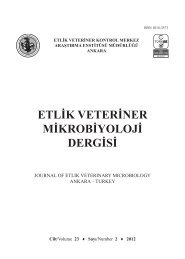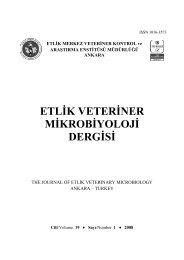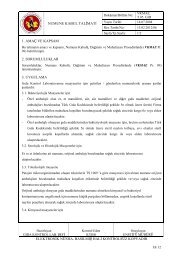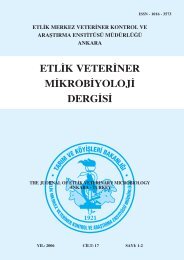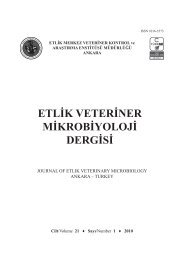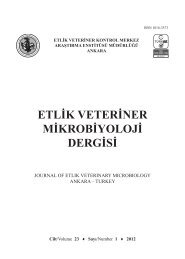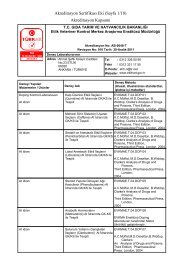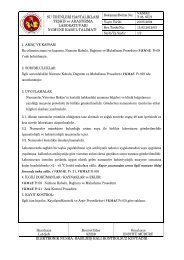etlik veteriner mikrobiyoloji dergisi - veteriner kontrol merkez ...
etlik veteriner mikrobiyoloji dergisi - veteriner kontrol merkez ...
etlik veteriner mikrobiyoloji dergisi - veteriner kontrol merkez ...
You also want an ePaper? Increase the reach of your titles
YUMPU automatically turns print PDFs into web optimized ePapers that Google loves.
82<br />
Günaydın E ve Şen S. Etlik Vet Mikrobiyol Derg, 22, 79-82, 2011<br />
ve diğer mobil elementlerle etkileşimi, Salmonella<br />
enterica’nın virulensinin moleküler mekanizmasını<br />
gün ve gün daha fazla anlamamıza yol açacaktır.<br />
Kaynaklar<br />
1. Schmidt H, Hensel M, (2004). Pathogenicity islands in bacterial<br />
pathogenesis. Clin Microbiol Rev. 17, 14-56.<br />
2. Groisman EA, Ochman H, (1996). Pathogenicity islands:<br />
bacterial evolution in quantum leaps. Cell. 87, 791-794.<br />
3. Sandra LM, Brumell JH, Pfeifer CG, Finlay BB, (2000).<br />
Salmonella pathogenicty islands: big virulence in small<br />
packages. Microb and Infec. 2, 145-156.<br />
4. Hensel M, (2004). Evolution of pathogenicity islands of Salmonella<br />
enterica. Int J Med Biol. 291, 95-102.<br />
5. Collazo CM, Galan JE, (1997), The invasion-associated<br />
type-III protein secretion system in Salmonella. Gene. 192,<br />
51-59.<br />
6. Groisman EA, Ochman H, (1997). How Salmoella became<br />
a pathogen. Trends in Microbiol. 5, 343-349.<br />
7. Suarez M, Rüssmann, (1998). Molecular mechanisms of<br />
Salmonella invasion: the type III secretion system of the<br />
pathogenicity island 1. Microbiol. 1, 197–204.<br />
8. Jones BD, Falkow S, (1994). Identification and characterization<br />
of a Salmonella typhimurium oxygen-regulataed<br />
gene required for bacterial internalization. Infect Immun.<br />
62, 3745-3752.<br />
9. Fu Y, Galan JE, (1998). The Salmonella typhimurium tyrosine<br />
phosphatase SptPis translocated into host cells and distrupts<br />
the actin cytoskeleton. Mol Micobiol. 27, 359-368.<br />
10. Hensel M, Shea JE, Baumler AJ, Gleeson C, Blattner<br />
FR, Holden DW, (1997). Analysis of boundaries of Salmonella<br />
pathogenicity island 2 and the corresponding choromosomal<br />
region of Escherichia coli K-12. J Bacteriol. 179,<br />
1105-1111.<br />
11. Hensel M, Nikolaus T, Egelseer C, (1999a). Molecular and<br />
functional analysis indicates mosaic structure of Salmonella<br />
pathogenicity Island 2. Mol Microbiol. 31, 489-498.<br />
12. Hensel M, Hinsley AP, Nikolaus T, Sawers G, Berks BC,<br />
(1999b). The genetic basis of Salmonella Typhimurium.<br />
Mol Microbiol. 32, 275-288.<br />
13. Hensel M, Shea JE, Waterman SR, Mundy R, Nikolaus<br />
T, Banks G, Vazquez-Torres A, Gleeson C, Fang FC,<br />
Holden DW, (1998). Genes encoding putative effector proteins<br />
of the type III secretion system of Salmonella pathogenicity<br />
island 2 are required for bacterial virulence and proliferation<br />
in macrophages. Mol Microbiol. 30, 163-174.<br />
14. Blanc-Potard AB, Solomon F, Kayser J, Groisman EA,<br />
(1999). The SPI-3 pathogenicity islands of Salmonella enterica.<br />
J Bacteriol. 181, 998-1004.<br />
15. Amavisit P, Lightfoot D, Browning GF, Markham PF,<br />
(2003). Variation between pathogenic serovars within<br />
Salmonella pathogenicity islands. J Bacteriol. 185, 3624-<br />
3635.<br />
16. Wong KK, McClelland M, Stillwell LC, Sisk EC, Thurston<br />
SJ, Saffer JD, (1998). Identification and sequence<br />
analysis of a 27-kilobase chromosomal fragment containing<br />
a Salmonella pathogenicity island located at 92 min<br />
on the choromosome map of Salmonella enterica serovar<br />
typhimurium LT2. Infect Immun. 66, 3365-3371.<br />
17. Chen LM, Kaniga K, Galan JE, (1996). Salmonella spp.<br />
are cytotoxic for cultured macrophages. Proc Natl Acad<br />
Sci. USA. 93, 4197-4201.<br />
18. Parkhill J, Dougan G, James KD, Thomson NR, Bentley<br />
SD, Holden MT, Sebaihia M, Baker S, Basham D,<br />
Brooks K, Chilingworth T, Connerton P, Cronin A, Davis<br />
P, Davies RM, Dowd L, White N, Farrar J, Feltwell<br />
T, Hamlin N, Haque A, Hien TT, Holroyd S, Jagels K,<br />
Krogh A, Larsen TS, Leather S, Moule S, O’Gora P,<br />
Parry C, Quail M, Rutherford K, Simmonds M, Skelton<br />
J, Stevens K, White head S, Barrell BG, (2001). Complete<br />
genome sequence of a multiple drug resistant Salmonella<br />
enterica serovar Typhi CT18. Nature. 413,848-852<br />
19. Folkesson A, Lofdahl S, Normark S, (2002). The Salmonella<br />
enterica subspecies I specific centisome 7 genomic<br />
island encodes novel protein families present in bacteria<br />
living in close contact with eukaryotic cells. Res Microbiol.<br />
153, 537-545.<br />
20. Zhang XL, Morris C, Hackett J, (1997). Molecular clonning,<br />
nucleotide sequences, and function of a site-specific<br />
recombinase encoded in the major ‘pathogenicity island’ of<br />
Salmonella Typhi. Gene. 202, 139-146.<br />
21. Hansen-Wester I, Hensel M, (2002). Genome based identification<br />
of choromosomal regions specific for Salmonella<br />
spp. Infect Immun. 70, 2351-2360.<br />
22. Seth-Smith HMB, (2008). SPI-7: Salmonella’s Vi-encoding<br />
pathogenicity island. J. Infect. Developing Countries.<br />
2, 267-271.<br />
23. Pickard D, Wain J, Baker S, Line A, Chohan S, Fookes<br />
M, Barron A, Gaora PO, Chabalgoity JA, Thanky N,<br />
Scholes C, Thomson N, Quail M, Parkhill J, Dougan G,<br />
(2003). Composition, acquisition, and distribution of the Vi<br />
exopolysaccharide-encoding Salmonella enterica pathogenicity<br />
island SPI-7. J Bacteriol. 185, 5055-5065.<br />
24. Saroj SD, Shashidhar R, Karani M, Bandekar JR,<br />
(2008). Distribution of Salmonella pathogenicity island<br />
SPI-8 and SPI-10 among different serotypes of Salmonella.<br />
J Med Microbiol, 57, 424-427.<br />
25. Towsend SM, Kramer NE, Edwards R, Baker S, Hamlin<br />
N, Simmonds M, Stevens K, Maloy S, Parkhill J, Dougan<br />
G, Baumbler AJ, (2001). Salmonella enterica serovar<br />
Typhi posseses a unique repertoire of fimbrial gene sequences.<br />
Infect Immun. 69, 2894-2901.



